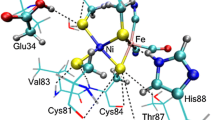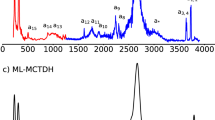Abstract
Quantum-chemical calculations were performed for the (NH3)3Zn2+...(H2O)n...NH3 (n = 3–11) molecular complex to model the proton transfer system of the carboanhydrase enzyme. H-bond proton transfer along the chain connecting the donor and acceptor groups was shown to be concerted vibrational motion of all protons in the chain. A wave of H-bond deformations was related to the moving proton. The displacement of H-bond protons in the transition state of the proton transfer reaction with respect to their equilibrium positions corresponded to a structure that could be defined as a proton wave. The length of this wave found as the distance between H-bond contraction (O-H bond elongation) maxima was ∼8 Å. Charge transfer from the donor to the acceptor occurred according to the mechanism of the concerted jump of H-bond protons as the wave reached the chain end. The barrier to transfer was independent of the number of chain links and equaled 10 kcal/mol.
Similar content being viewed by others
References
J. F. Nagle and H. J. Morowitz, Proc. Natl. Acad. Sci. U.S.A. 75, 298 (1978).
S. Iwata, C. Ostermeier, B. Ludwig, and H. Michel, Nature (London) 376, 660 (1995).
R. Pomes and B. Roux, Biophys. J. 75, 33 (1998).
D. Marx, M. E. Tukerman, J. Hutter, and M. Parrinello, Nature (London) 397, 601 (1999).
H. Decornez, K. Drukker, and S. Hammes-Schiffer, J. Phys. Chem. A 103, 2891 (1999).
Y. Y. Sham, I. Muegge, and A. Warshel, Proteins: Struct., Funct., Genet. 36, 484 (1999).
M. Wikström, Curr. Opin. Struct. Biol. 8, 480 (1998).
I. Hofacker and K. Schulten, Proteins: Struct., Funct., Genet. 30, 100 (1998).
V. K. Rastogi and M. E. Girvin, Nature (London) 402, 263 (1999).
M. H. B. Stowell, T. M. McPhillips, D. C. Rees, et al., Science (Washington D.C.) 276, 812 (1997).
M. Akeson and D. W. Deamer, Biophys. J. 60, 101 (1991).
S. J. Dodgson, R. E. Tashian, G. Gross, and N. D. Carter, The Carbonic Anhydrases (Plenum, New York, 1991).
G. L. Shearer, K. Kim, K. M. Lee, et al., Biochemistry 32, 11 186 (1993).
D. N. Silverman, C. K. Tu, S. Lindskog, and G. C. Wynns, J. Am. Chem. Soc. 101, 6734 (1979).
C. A. Lesburg and D. W. Christianson, J. Am. Chem. Soc. 117, 6838 (1995).
A. Isaev and S. Scheiner, J. Phys. Chem. B 105, 6420 (2001).
Q. Cui and M. Karplus, J. Am. Chem. Soc. 107, 1071 (2003).
S. Toba, G. Colombo, and K. M. Merz, Jr., J. Am. Chem. Soc. 121, 2290 (1999).
M. J. Frisch, G. W. Trucks, H. B. Schlegel, et al., Gaussian, 98, revison A.11.3 (Gaussian Inc., Pittsburg, PA, 2002).
Author information
Authors and Affiliations
Additional information
Original Russian Text © A.N. Isaev, 2007, published in Zhurnal Fizicheskoi Khimii, 2007, Vol. 81, No. 6, pp. 1058–1063.
Rights and permissions
About this article
Cite this article
Isaev, A.N. The wave nature of the protonic conductivity mechanism in the active site of carboanhydrase. Russ. J. Phys. Chem. 81, 924–928 (2007). https://doi.org/10.1134/S0036024407060155
Received:
Issue Date:
DOI: https://doi.org/10.1134/S0036024407060155




